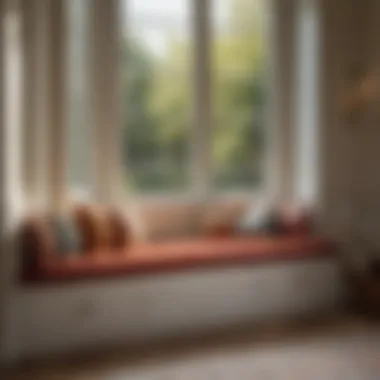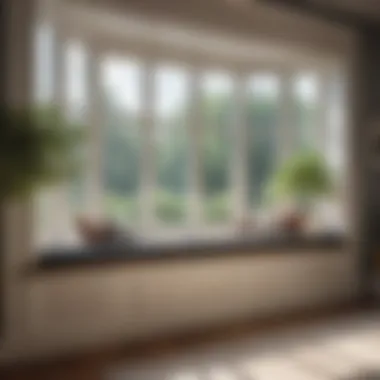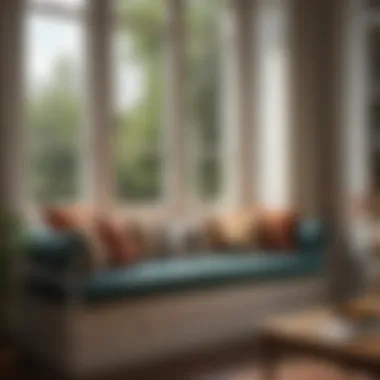Intro
Bay window benches with drawers serve an important function in modern residential design. They are more than just an attractive piece of furniture; they combine utility with aesthetic appeal, enriching the living spaces where they are placed. This article will navigate through the various aspects of incorporating these benches into your home, from material selection to installation and design ideas. By the end, you will understand how these fixtures not only enhance your home decor but also provide much-needed storage.
Materials:
Crafting a bay window bench with drawers requires a clear list of materials. Below are the essential items you'll need for this DIY project:
- Plywood sheets (3/4 inch thick) – 2 sheets, size 4'x8'
- 2x4 lumber – 5 pieces, length 8 feet
- Wood screws – 1 box, 1.5 inches long
- Wood glue – 1 bottle
- Drawer slides – 4 sets, 16 inches long
- Handles – 4 pieces
- Sandpaper (various grits)
- Paint or wood stain – 1 quart (or as needed)
- Sealer (optional) – 1 bottle
- Cushions for seating – size based on your design
- Foam or batting for cushion filling (if making custom cushions)
DIY Steps:
Step 1: Planning
Before you begin, visualize the final product and take accurate measurements of the space where the bench will go. Design your bench according to the space available, considering dimensions for comfort and storage needs.
Step 2: Cutting the Wood
Using a circular saw, cut the plywood sheets into the following pieces:
- Bench seat – 1 piece (size will depend on your measurements)
- Bench sides – 2 pieces (height as desired, depth 18 inches)
- Backrest (optional) – 1 piece (height as desired, width matching the bench seat)
- Drawer fronts – according to the size of drawers planned, typically two panels measuring 24 inches wide by 6 inches high.
Step 3: Assembling the Frame
Construct a rectangular frame using the 2x4 lumber and wood screws. Ensure it’s sturdy to hold the bench and drawers.
- Attach the frame to the floor using anchors for extra stability.
- Attach sides to the frame and secure the backrest if using one.
Step 4: Drawer Assembly
- Construct the drawers using the cut plywood pieces.
- Install drawer slides on the sides of the bench frame first, then install them on the drawers.
- Make sure the slides are level.
Step 5: Finishing Touches
Sand all surfaces to ensure a smooth finish. Apply the paint or stain as preferred and let it dry thoroughly. If desired, apply a sealer for added protection.
Step 6: Cushioning
Cover your cushions with chosen fabric. If making your own, cut foam or batting to size and assemble them into the fabric covers before placing them on the bench.
Technical Aspects:


Tools Required:
- Circular saw
- Drill
- Screwdriver
- Measuring tape
- Level
Timing Specifics:
- Planning: 1-2 hours
- Cutting: 2-3 hours
- Assembly: 3-4 hours
- Finishing: 2 hours drying time
Critical Techniques:
- Measurement Accuracy: Ensure all cuts are precise to fit properly.
- Level and Alignment: Check each step for level surfaces to avoid unevenness.
DIY Project Process:


Installation Method:


- Begin by securing the frame properly to the ground.
- Install the bench seat and backrest.
- Attach the drawer fronts uniformly to ensure they align when closed.
Troubleshooting Tips:
- If drawers stick, ensure slide installation is level and adjusted correctly.
- For misaligned pieces, double-check measuring and cut dimensions to correct any issues.
Incorporating functional designs into residential spaces helps improve both storage and aesthetics, creating a balanced living atmosphere.
This guide serves as a solid foundation for creating your own bay window bench with drawers. With careful planning and execution, your DIY project will become a valuable addition to your home.
Foreword to Bay Window Benches with Drawers
Bay window benches with drawers present a unique fusion of functionality and aesthetics in contemporary home design. These benches create a cozy place to sit, while their integrated drawers offer much-needed storage solutions in various living spaces. A bay window often serves as a focal point in a room, allowing for increased natural light and an enhanced view of the outdoors. By adding benches with drawers, home owners not only make efficient use of this space but also contribute positively to the overall decor.
The design of bay window benches can greatly influence how a room feels and looks. They provide a place for relaxation, reading, or enjoying a cup of coffee. The drawers help to keep the area clutter-free, making it easier to maintain an organized living environment. When considering the installation of a bay window bench, it is essential to think about both its primary function and the visual impact on the room.
Using benches with drawers can help to maximize storage while keeping the design stylish. They allow for the concealment of items that might otherwise create an unnecessary mess. Thus, a bay window bench can be both a practical and an attractive addition to any home.
"A well-designed bay window bench can transform both the functionality and aesthetic of a living space, offering greater utility without compromising style."
These benches can complement a variety of decor styles, adding texture and character to the living environment. In essence, they serve as a blend of utility, comfort, and beauty, which is increasingly important in today’s busy lifestyles.
The Practical Benefits of Benches with Drawers
Bay window benches with drawers offer significant advantages that cater to both aesthetics and functionality in home design. They serve as practical solutions to common challenges like storage and maximizing the utility of underused spaces. In smaller rooms, where every inch counts, these benches transform what may be a neglected area into a focal point that combines comfort with practicality.
Maximizing Space in Smaller Rooms
In urban homes, space can often be a constraint. Bay window benches with drawers make use of often overlooked areas. By incorporating seating with built-in storage, homeowners can efficiently utilize corner spaces or nooks that would not serve a purpose otherwise.
These benches invite the use of what might be wasted space, thus allowing for better room arrangement without overcrowding. They provide comfort for sitting while also offering a clever solution for storage that does not inhibit room flow.
Organizational Efficiency
Organizational efficiency is paramount in maintaining a tidy home, and benches with drawers significantly contribute to this goal. They enable homeowners to keep items organized and easily accessible without cluttering floors or surfaces.
Storing Seasonal Items
Storing seasonal items within the drawers of bay window benches is particularly advantageous. In many households, seasonal decor and belongings can take up valuable space. A bay window bench serves as an ideal storage solution, keeping these items neatly tucked away when not in use.
The key characteristic of this storage method is its ability to hide away decorations, clothes, or other seasonal items, reducing visual clutter during off-peak seasons. It is a popular choice because it not only frees up space but also keeps the items protected from dust or damage.
Advantages include ease of access, as homeowners can retrieve their items whenever needed without the hassle of searching through multiple storage areas. On the downside, if the drawer space becomes limited, some items may still be stored elsewhere, leading to potential clutter.
Concealing Clutter
Concealing clutter is another important aspect of benches with drawers. In any home, retaining order can be a challenge, especially in common areas. A bay window bench with drawers helps to address this issue.
The primary feature of this solution is its ability to store everyday items out of sight. This keeps living spaces looking tidy and more inviting. As such, it has become a favored solution for many households.
A significant advantage of this design is that it provides a dedicated location for stray items, preventing them from accumulating in open spaces. However, one downside might be that if drawers are not organized, they could easily become chaotic, negating their purpose of concealing clutter.
Aesthetic Considerations
The aesthetic considerations surrounding bay window benches with drawers play a crucial role in integrating these pieces into a home’s overall design scheme. These features are not just about form; they also embody functionality and style. Ensuring that a bay window bench resonates with the existing decor is vital for creating a harmonious living environment. Homeowners and interior designers often grapple with how to blend these benches into spaces without compromising the original aesthetic. A successful design encourages visual balance while optimizing utility, making this aspect paramount.
Complementing Existing Decor
In modern homes, it is imperative that every element adds to the overall atmosphere. A bay window bench should harmonize with other furniture pieces, textures, and colors in the room. Think about the themes that define the space. If a room radiates a rustic charm, a bench made of reclaimed wood may work wonders. On the other hand, a sleek, contemporary bench can amplify minimalistic environments, providing both practicality and uniqueness.
Key Considerations for Complementing Decor:
- Style: The style of the bench should blend flawlessly with the room. For instance, a Victorian-style space would benefit from ornately carved benches.
- Material: Consider what materials are used in other furnishings. This can include coordinating with fabrics or surface textures.
- Proportions: Pay attention to the size and form of the bench. A massive bench may overwhelm a small room, while an overly delicate piece might get lost in a large space.
Color Schemes and Finishes
The color scheme of a bay window bench can bridge the gap between practicality and aesthetics. Color choices may either complement existing tones or introduce new accents. The finish of the materials is equally important; it can enhance or diminish the vibrancy of the chosen colors.
Matching Materials
Matching materials is an effective strategy for creating cohesion across design elements. This means using similar wood types or finishes found in other furniture. For instance, if a living room features walnut-side tables, selecting a walnut bench will create a sense of belonging, making the space feel well-curated.
- Key Characteristics:
- Cohesion: Creates visual harmony with other design elements.
- Enduring Popularity: This method remains a popular choice due to its simplicity.
- Advantanges/Disadvantages: While it ensures consistency, it is less adventurous.
Contrast Techniques
On the flip side, contrast techniques provide an opportunity to create a statement piece. These involve selecting benches whose materials, colors, or patterns differ significantly from existing decor elements. For example, a bright upholstered bench contrasts with neutral walls and can add a pop of character.
- Key Characteristics:
- Visual Interest: This approach can draw the eye and stimulate conversation.
- Daring Choice: It often encourages creative expressions.
- Advantages/Disadvantages: While eye-catching, it may risk clashing with overpowering elements in the room.
Ultimately, whether leaning towards matching materials or using contrast techniques, the decision hinges on the desired effect and personal style. Both strategies hold merit depending on the homeowner's vision and aesthetic preferences.
Design Ideas for Bay Window Benches
The design of bay window benches is not just about aesthetics; it serves a dual purpose. An effective design can enhance the beauty of a space while providing functional storage. This section explores various design concepts for bay window benches. Each idea has its unique traits that can cater to different styles and preferences of housewives and homeowners alike.
Contemporary Designs
Contemporary designs for bay window benches incorporate simplicity and clean lines. These benches often feature minimalism and a functional approach. Neutral color palettes are common, with perhaps a splash of vibrant accent colors. The emphasis is on creating a sleek environment.
Key elements of contemporary designs include:
- Straight edges and geometric shapes.
- Use of modern materials like metal and glass.
- Integrated lighting for ambiance.
The storage aspect in contemporary designs often includes drawers or lift-top seating, promoting decluttered spaces. The effect is both practical and visually pleasing, making the area feel spacious.
Traditional Aesthetics
For those who appreciate classic beauty, traditional aesthetics in bay window benches are ideal. This style is marked by ornate details and rich materials. Wood is typically the primary material, adding warmth and character. The finishes are often sophisticated, such as mahogany or oak.
Aspects to consider in traditional designs:
- Intricate carvings or moldings.
- Rich, dark colors that create a cozy feel.
- Plush cushions to enhance comfort.
These benches often become the focal point of the room, merging well with other traditional decor elements. Their design reflects timelessness, appealing to those who value heritage in their home.
Eclectic Styles
Eclectic styles allow for personal expression and creativity. This design philosophy embraces mixing various elements, making each bay window bench unique. For homeowners who enjoy bold choices, eclectic designs can incorporate bright colors, diverse materials, and unexpected shapes.
Consider the following while embracing an eclectic design:
- Combine textures like wood, metal, and fabric.
- Use cushions in varied patterns and colors for a playful look.
- Integrate elements from different eras, giving a twist to the overall design.
An eclectic style provides the opportunity to showcase individuality in a home, allowing homeowners to create a cheering environment that reflects personal taste.
Material Selection for Benches
When it comes to bay window benches with drawers, the material selection plays a vital role. This decision affects not only the aesthetics of the space but also the functional aspects like durability and maintenance. Choosing the right materials allows homeowners to balance visual appeal with practicality.
The materials you select will influence the overall ambiance of the room. For instance, natural wood can create a warm, inviting atmosphere, while metal and glass may contribute to a more modern feel. Each material brings its own benefits and challenges, making it essential to consider factors such as usage, climate, and decor style.
Wood Options
Wood is a timeless choice for bay window benches. Its versatility allows for a variety of styles, from traditional to contemporary. However, within wood options, there are softwoods and hardwoods.
Softwoods vs. Hardwoods
Softwoods, typically from coniferous trees, are often lighter and less dense than hardwoods. These materials, such as pine and cedar, are popular for their ease of manipulation and cost-effectiveness. They can take on stains and finishes easily, thus providing plenty of design flexibility. However, they may not offer the same level of durability as hardwoods.
On the other hand, hardwoods like oak, maple, or walnut provide superior strength and resistance to wear. Their density means they can withstand heavy use, making them ideal for furniture that will see a lot of traffic. However, hardwoods can come at a higher price point and may require more maintenance to keep them looking their best.
Choosing between softwoods and hardwoods often comes down to balancing budget with desired longevity and appearance.
Finishes and Treatments
Finishes and treatments are critical in enhancing the performance and look of wood benches. A good finish can protect the wood from moisture, scratches, and fading, ensuring the longevity of your furniture. Polyurethane, varnish, or oil finishes create a protective layer that not only shields but also enhances the aesthetic appeal—highlighting the natural grain of the wood.
However, not all finishes are created equal. Oil finishes penetrate the wood and provide a more natural look while varnishes form a protective coat. Depending on usage, you may choose a finish that can handle spills or one that promotes easy cleaning.
Alternative Materials
While wood is a common material choice, alternative options can also achieve beautiful and functional results. Plates made from metal or glass, or combinations of both, are becoming increasingly popular.
Metal and Glass Combinations
Metal and glass combinations offer a sleek and modern look. The use of glass can brighten up a space while allowing light to flow, creating an airy feel. Metal may provide a structural element that can hold up to rigorous use. However, these materials often require specific treatments to avoid rust or scratching.
The balance of materials typically brings about a contemporary charm that blends well with minimalist designs. It can also be more forgiving in maintenance, as surfaces can be wiped clean without much effort.
Composite Materials
Composite materials are engineered for balance and efficiency. They tend to mimic the look of wood, while providing advantages such as resistance to weather and pests. Products like plywood and engineered wood are durable and can be custom-fitted to unique spaces.
The lightweight nature of composites makes them easier to work with during installation. They can also be treated to match any style, providing flexibility not always available with solid wood.
Installation Considerations
When incorporating bay window benches with drawers into your home, understanding the installation considerations is vital. This section not only addresses practical aspects but also influences the overall aesthetic and functionality of the space. Proper installation ensures that the bench fits seamlessly within the bay window, enhances the room's layout, and serves its intended purpose effectively.
Measuring and Planning
Measuring is an essential first step in the installation process. Accurate dimensions help to determine the appropriate size of your bench. Start by measuring the width, depth, and height of the bay window nook. Consider the following points:
- Width: Measure from wall to wall at the base of the window. A precise measurement will allow you to determine how much material you will need.
- Depth: The depth should be sufficient for comfort. Typically, a depth of 18 to 24 inches is ideal, allowing room for pillows and seating.
- Height: The height should align with existing furniture for cohesion. A bench that sits too high or low can disrupt the flow of the room.
Planning goes hand in hand with measuring. Once you have the numbers, sketch a layout. This visual representation will help you determine how the bench will fit into your design scheme. Take into account:
- Access to Drawers: Ensure there is enough clearance for the drawers to open and close without obstruction.
- Window Views: The bench placement should not block any views or natural light.
- Surrounding Decor: Visualize how the bench's style will fit with existing furniture or design elements in the space.
DIY vs. Professional Installation
Deciding whether to undertake a DIY project or hire a professional can greatly change the installation experience. Both options have unique benefits and challenges.
Doing it Yourself (DIY):
- Cost Savings: One of the main advantages is the potential for reduced costs. You save on labor fees, allowing you to allocate funds for quality materials or additional decor.
- Customization: DIY installation gives you total control over the design and execution. You can tailor every detail to fit your personal vision.
- Sense of Achievement: Successfully installing your bench can provide a strong sense of accomplishment.
However, DIY projects come with risks:
- Lack of experience could lead to measurement mistakes or installation errors.
- Required tools might not be readily available.
Hiring Professionals:
- Expertise: Professionals bring valuable skills and experience. They have the knowledge to tackle unexpected challenges that may arise during installation.
- Time-Saving: With a professional, the process typically goes faster. They can complete the work efficiently, allowing you to enjoy your new bench sooner.
- Quality Assurance: A professional installation often comes with a guarantee of quality. This added peace of mind can be invaluable.
On the other hand, hiring a professional incurs additional costs. Ensure that you have a clear understanding of fees involved to avoid surprise expenses.
Maintenance of Bay Window Benches
The maintenance of bay window benches with drawers is crucial to ensure both their aesthetic charm and practical functionality. Regular upkeep prevents wear and tear, enhances durability, and sustains the elegance of the piece. Understanding the specific maintenance needs can help homeowners preserve this cherished element of their home.
Good maintenance practices allow these benches to serve not just as decorative accents but also as efficient storage solutions. Moreover, it creates a welcoming environment that harmonizes with the overall decor of the room. This section elaborates on the essential cleaning techniques and periodic maintenance recommendations to keep your bay window benches in optimal condition.
Cleaning Techniques
Maintaining cleanliness is the first step in ensuring that bay window benches remain attractive and functional. Here are some effective cleaning strategies:
-
Dust Regularly: Use a soft cloth or a microfiber duster to capture dust and debris that may accumulate on the surface.
-
Use Mild Cleaners: For deeper cleaning, mix warm water with a small amount of mild detergent. Avoid harsh chemicals that can damage the finish.
-
Wipe Down Drawers: Extend your cleaning routine to the drawers as well. Clear out contents and wipe the insides to remove dust and dirt.
-
Avoid Soaking: Never soak wooden surfaces. Excess moisture can warp the wood or affect the adhesives that hold the construction together.
These methods are simple but effective in maintaining the overall look and feel of your benches.
Periodic Maintenance Recommendations
To extend the lifespan of bay window benches, it is vital to implement periodic maintenance practices. Here are some recommendations:
-
Inspect for Damage: Regularly check for any signs of damage such as scratches or dents. Address these issues promptly to prevent further deterioration.
-
Reapply Finishes: Depending on the material, applying a new coat of finish may be necessary. For wooden benches, consider re-oiling or refinishing every few years to maintain luster.
-
Lubricate Hardware: If your bench features drawers, lubricate the sliding mechanisms. This practice ensures smooth operation and increases longevity.
-
Monitor Humidity Levels: Wood is sensitive to humidity. Consider a dehumidifier in summer months to prevent warping and mold growth.
Key Takeaway: Regular maintenance not only preserves visual appeal but also guarantees that the functional elements of the benches, like the drawers, perform effectively for years to come.
By diligently following these cleaning techniques and maintenance recommendations, homeowners can enjoy the benefits of their bay window benches while maintaining their aesthetic appeal and practicality.
End
In summing up the discussion regarding bay window benches with drawers, this article underscores their dual role of functionality and aesthetic appeal within interior design. These benches are not just seating solutions; they markedly enhance the usability of space, particularly in smaller rooms. The inclusion of drawers transforms what might be a passive area into a dynamic storage opportunity, helping to reduce clutter. This function contributes to a more organized home environment.
Summary of Key Points
- Versatility: Bay window benches serve as both seating and storage furniture, fulfilling diverse needs within a living space.
- Space Maximization: Ideal for small or awkwardly shaped rooms, these benches utilize space efficiently, making the most of natural light while providing comfort.
- Aesthetic Integration: They can be designed to complement the existing decor or to stand as bold design statements. Choices in materials and colors can reflect personal style, enriching the ambiance of the home.
- Maintenance: Regular cleaning and care keep bay window benches looking new and prolong their lifespan, essential for maintaining their functionality.
- Trends in Design: As trends shift, the design possibilities for these benches continue to evolve, allowing homeowners to adapt them to changing interior themes.
Future Trends in Design
Looking ahead, the trends surrounding bay window benches with drawers are evolving. Homeowners increasingly seek personalized and multifunctional fixtures. Sustainable materials are becoming more popular, with a focus on eco-friendly woods and composites that minimize environmental impact.
Another trend is the customization of these benches to fit unique space requirements and personal preferences. Technological integration, such as built-in charging ports and lighting, is also gaining attention. Furthermore, minimalism continues to influence designs, prompting cleaner lines and simpler constructions that focus on functionality without sacrificing style.
Ultimately, the future holds exciting possibilities for bay window benches, as they adapt to meet both practical needs and aesthetic desires. Homeowners are likely to find that these pieces are not just furniture but integral parts of a more thoughtfully designed living space.





